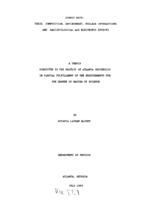- Collection:
- Atlanta University and Clark Atlanta University Theses and Dissertations
- Title:
- Cosmic rays their composition, environment, nuclear interactions and radiobiological and electronic effects, 1989
- Creator:
- Blount, Octavia L.
- Date of Original:
- 1989-07-01
- Subject:
- Degrees, Academic
Dissertations, Academic - Location:
- United States, Georgia, Fulton County, Atlanta, 33.749, -84.38798
- Medium:
- theses
- Type:
- Text
- Format:
- application/pdf
- Description:
- Cosmic rays consist of atomic nuclei ranging from H to U. They are the most energetic particles in nature, with energies 106 eV to lO^1 eV. They are of Galactic origin and are probably produced by supernova shock waves that accelerate stellar flare particles. The composition of cosmic rays at the sources resembles that of normal stars like the sun; (with modifying factors due to the first ionization potential effects and nucleosynthesis processes in WoIf-Rayet stars). The propagation equation, with the calculated cross sections of Silberberg and Tsao, yields a mean path length traversed in interstellar gas of - 5 g/cm^ near energies of 4 GeV per nucleon, with a confinement time of 10^ years (determined by the extent of survival of the long-lived radio-active nuclide Be10 ). Calculations combined with the latest experimental data on cosmic-ray relative abundances show that the cosmic-ray path lengths have an exponential distribution. Improvements in the cross section calculations of Silberberg and Tsao, from Z = 14 to 19, were made. Comparisons of HETC (high energy transport code) and experimental data for nuclear recoil energy spectra uncovered a systematic error in HETC; a new correction factor of exp(.03*E) is proposed. Protection from cosmic radiation is handled through shielding. The Earth's magnetic field and atmosphere serve as a good shielding mechanism; but radiation hazards are significant outside the Earth's atmosphere. A new mean quality factor, - 14, was derived for neutrons by integrating over their energy spectrum. Examples of radiation protection are presented, using the new quality factor, to aid in the prevention of biological damage to human tissue. And damage to electronic components (single event upsets) is explored.
- External Identifiers:
- Metadata URL:
- http://hdl.handle.net/20.500.12322/cau.td:1989_blount_octavia_l
- Rights Holder:
- Clark Atlanta University
- Holding Institution:
- Atlanta University Center Robert W. Woodruff Library
- Rights:
-
